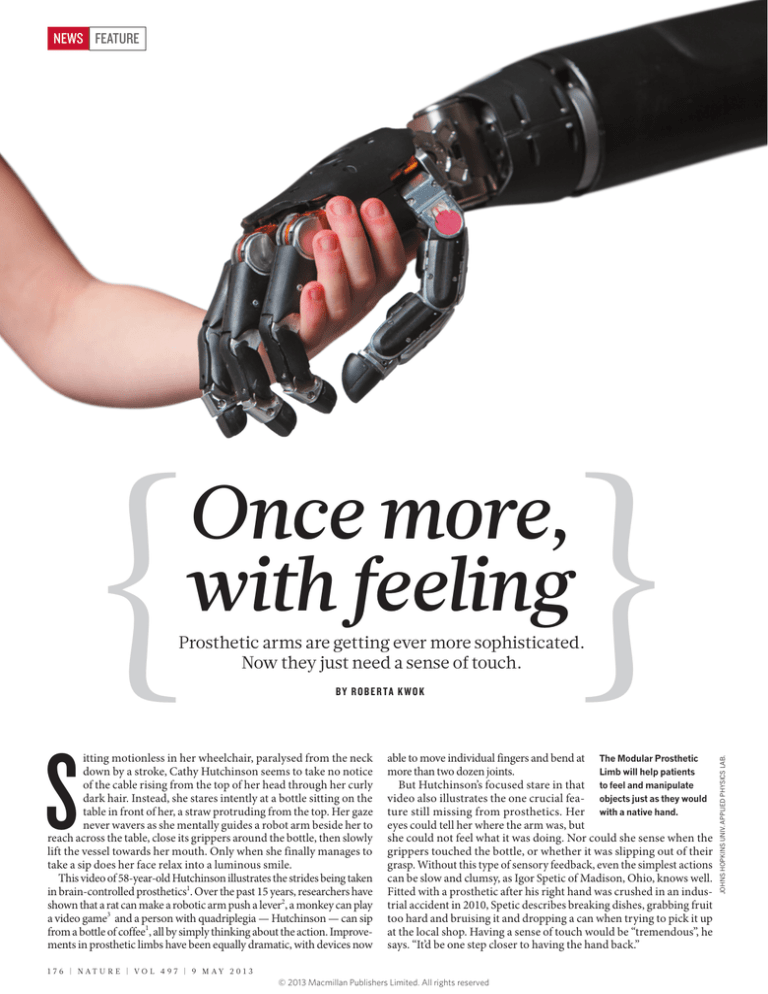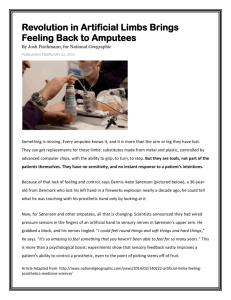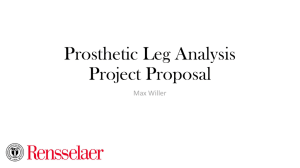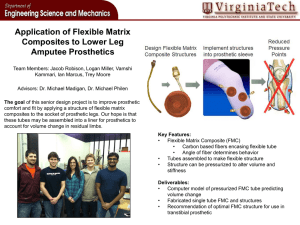
NEWS FEATURE
{
Once more,
with feeling
}
S
B Y R O B E R TA K W O K
itting motionless in her wheelchair, paralysed from the neck
down by a stroke, Cathy Hutchinson seems to take no notice
of the cable rising from the top of her head through her curly
dark hair. Instead, she stares intently at a bottle sitting on the
table in front of her, a straw protruding from the top. Her gaze
never wavers as she mentally guides a robot arm beside her to
reach across the table, close its grippers around the bottle, then slowly
lift the vessel towards her mouth. Only when she finally manages to
take a sip does her face relax into a luminous smile.
This video of 58-year-old Hutchinson illustrates the strides being taken
in brain-controlled prosthetics1. Over the past 15 years, researchers have
shown that a rat can make a robotic arm push a lever2, a monkey can play
a video game3 and a person with quadriplegia — Hutchinson — can sip
from a bottle of coffee1, all by simply thinking about the action. Improvements in prosthetic limbs have been equally dramatic, with devices now
able to move individual fingers and bend at The Modular Prosthetic
more than two dozen joints.
Limb will help patients
But Hutchinson’s focused stare in that to feel and manipulate
video also illustrates the one crucial fea- objects just as they would
ture still missing from prosthetics. Her with a native hand.
eyes could tell her where the arm was, but
she could not feel what it was doing. Nor could she sense when the
grippers touched the bottle, or whether it was slipping out of their
grasp. Without this type of sensory feedback, even the simplest actions
can be slow and clumsy, as Igor Spetic of Madison, Ohio, knows well.
Fitted with a prosthetic after his right hand was crushed in an industrial accident in 2010, Spetic describes breaking dishes, grabbing fruit
too hard and bruising it and dropping a can when trying to pick it up
at the local shop. Having a sense of touch would be “tremendous”, he
says. “It’d be one step closer to having the hand back.”
1 7 6 | NAT U R E | VO L 4 9 7 | 9 M AY 2 0 1 3
© 2013 Macmillan Publishers Limited. All rights reserved
JOHNS HOPKINS UNIV. APPLIED PHYSICS LAB.
Prosthetic arms are getting ever more sophisticated.
Now they just need a sense of touch.
FEATURE NEWS
Prosthetics researchers are now trying to grant him that wish by
creating prosthetics that can ‘feel’ more like the real thing. It is a
daunting task: researchers have managed to read signals from the
brain; now they must write information into the nervous system.
Touch encompasses a complicated mix of information — everything
from the soft prickliness of a woollen top to the slipping of a sweaty
soft-drink can. The research is still in its infancy, with approaches that
range from stimulating nerves in a stump and re-routing nerves to
other parts of the body, to tapping directly into the brain (see ‘Closing
the loop’). But “it’s probably the next big thing that has to happen”,
says Robert Kirsch, a biomedical engineer at Case Western Reserve
University in Cleveland, Ohio.
ALTERNATIVE SENSES
ILLUSTRATION: JASIEK KRZYSZTOFIAK; SOURCE: JOHNS HOPKINS UNIV. APPLIED PHYSICS LAB.
Conventional prosthetics are not devoid of feedback. The widely used
‘split-hook’ hand replacement, for instance, typically has a harness
that lets the user open and close the device by moving another part of
the body, such as the opposite shoulder; patients then feel resistance
in the harness when they grab something. Likewise, users of motorized prosthetics — which are controlled by electrical signals from
muscles in the stump — will feel pressure on the stump when they
push something, or may hear subtle changes in the motor’s sound
when grabbing an object. Researchers have even tried to introduce
such feedback deliberately, through vibrations, air pressure and electrical stimulation.
But none of these sensations feels natural — which may be one
reason that many people reject prosthetic limbs: the replacement just
doesn’t seem like part of the body.
Recreating life-like sensation is a tall order. The sensations arise
from a host of receptors in the skin, which detect texture, vibration,
pain, temperature and shape, as well as from receptors in the muscles,
joints and tendons that contribute to ‘proprioception’ — the sense of
where a limb is in space. Prosthetics are being outfitted with sensors
that can gather many of these sensations, but the challenge is to get
the resulting signals flowing to the correct part of the brain.
For people who, like Spetic, have had limbs amputated, the obvious
way to achieve that is to route the signals into the remaining nerves
in the limb’s stump. Researchers including Ken Horch, a neuro­
prosthetics researcher at the University of Utah in Salt Lake City,
have done just that by threading electrodes into the nerves in stumps
then stimulating them with a tiny current, so that patients felt like
their fingers were moving or being touched4.
The technique can even allow patients to distinguish basic features
of objects: a man who had lost his lower arms was able to determine
the difference between blocks made of wood or foam rubber by
using a sensor-equipped prosthetic hand. He correctly identified the
objects’ size and softness more than twice as often as would have been
expected by chance5. Information about force and finger position was
delivered from the prosthetic to a computer, which prompted stimulation of electrodes implanted in his upper-arm nerves. Researchers
at Florida International University in Miami are now working to
build an implantable device using the technique.
But some researchers worry that implanting electrodes directly
into a nerve could damage it. Dustin Tyler, a biomedical engineer at
Case Western Reserve University, and his colleagues have therefore
developed a cuff-like electrode that encircles the nerve. “We want to
get access to as much of the nerve as we can without actually penetrating into it,” says Tyler. The researchers showed that by running
current to the cuffs in cats, they could precisely activate nerves and
make the animals move their feet in specific directions6. They are
now trying to stimulate nerves that carry sensory information. Their
first patient — Spetic — had the cuffs implanted in his forearm last
May, says Tyler, and can feel “very natural sensation” at multiple
spots. The team is now testing the electrodes in a second patient.
COMPLEX SENSATION
As promising as such results are, researchers will probably need to
stimulate hundreds or thousands of nerve fibres to create complex
sensations, and they will need to keep the devices working for many
years if they are to minimize the number of surgeries required to
replace them. So some researchers are instead trying to give patients
sensory feedback by touching their skin.
This technique was discovered by accident in 2002, when a group
led by Todd Kuiken, director of the Center for Bionic Medicine at
the Rehabilitation Institute of Chicago in Illinois, was testing a way
to improve patients’ control of their prosthetic limbs. The idea was
to rewire arm nerves that used to serve the hand, for example, to
muscles in other parts of the body. When the patient thought about
closing his or her hand, the newly targeted muscle would contract
and generate an electric signal, driving movement of the prosthetic.
The first patient to receive this ‘targeted reinnervation’ therapy was
Jesse Sullivan, a power-line engineer who had lost both arms from
electrical burns. After his arm nerves were re-routed to his chest
muscles, Sullivan could operate a prosthetic hand just by thinking
about the actions. But to everyone’s surprise, he also began to feel
Closing the loop
Prosthetic limbs can be controlled by nerve signals flowing from the brain ( ). But
fast, fluid motion requires sensory feedback flowing back to the brain ( ). Sensorequipped prosthetics are under development (right), and researchers are exploring
several ways to route the output from the sensors into the nervous system (below).
Use the remaining nerves
Move the nerves
Stimulate the brain
Electrical leads from the
prosthetic’s sensors
stimulate nerves in the
person’s stump that
once served the real limb.
Re-routed nerves grow new
endings into muscle and
skin, where external devices
translate signals going to
and from the prosthesis.
Sensory signals are routed
around a severed spinal cord
and into the brain, where they
produce sensations by direct
stimulation of the cortex.
Fingertip sensors
Contact sensors
Joint sensors
9 M AY 2 0 1 3 | VO L 4 9 7 | NAT U R E | 1 7 7
© 2013 Macmillan Publishers Limited. All rights reserved
NEWS FEATURE
as though his missing hand was being touched when his chest was
touched. It turned out that the re-routed nerves had grown into the
chest skin, and his brain was interpreting the sensory signals as coming from his hand. Some parts of his chest felt like his palm, whereas
others felt like his fingers or forearm7.
The results raised the possibility that sensory information from a
prosthetic could be delivered to a device that pushes different parts
of the skin. For people who have had targeted reinnervation surgery,
pressure on the newly wired skin would then trigger sensations of
touch in the missing hand. The technique
isn’t perfect: the parts of the hand don’t map
neatly onto the reinnervated skin, and each
patient has a different map. And delivering
detailed sensory information from a prosthetic can be challenging, as the area for
stimulation is limited to a small patch of
skin. But even so, one of Kuiken’s former
colleagues is working with the company
HDT Robotics in Evanston, Illinois, to
make such a device, and Kuiken plans to
develop one as well.
DIRECT HIT
finely tuned technique to deliver them. With electrical stimulation,
all neurons close to the electrode’s tip are activated indiscriminately,
so “even if I had the sharpest needle in the Universe”, that could create
unintended effects, says Arto Nurmikko, a neuroengineer at Brown
University in Providence, Rhode Island. For example, an attempt to
create sensation in one finger might produce sensation in other parts
of the hand as well, he says.
Nurmikko and other researchers are therefore using light, in place
of electricity, to activate highly specific groups of neurons and recreate a sense of touch. They first used a technique called optogenetics to express genes
for light-sensitive proteins in parts of a
monkey’s brain that receive tactile information from the hand. They then trained
the monkey to remove its hand from a pad
when the device vibrated. When the team
then stimulated the brain with a light source
implanted in the animal’s skull, the monkey
lifted its hand off the pad about 90% of the
time, according to results reported at the
Society for Neuroscience meeting. The use
of such techniques in humans is still probably 10–20 years away, says Bensmaia, but
it is a promising strategy.
{}
“It’d be
one step
closer to
having
the hand
back.”
None of these techniques will work for
people who, like Hutchinson, have had a
stroke, or received spinal-cord injuries that
severed the nerve pathways from the limbs
to the brain. So some researchers are skipping directly to the brain. In principle, this
should be straightforward. Because signals
from specific parts of the body go to specific parts of the brain, scientists should be able to create sensations of touch or proprioception
in the limb by directly activating the neurons that normally receive
those signals.
This is immensely difficult to do, however, because scientists still
have an incomplete knowledge of which neurons those are. Researchers therefore have two options: identify and mimic the natural signals,
or make the brain learn a new set.
A team led by Sliman Bensmaia, a neuroscientist at the University
of Chicago, is taking the first approach. In one study, the researchers
repeatedly poked monkeys in two spots on the hand and trained the
animals to move their eyes left or right, depending on whether the
second poke was to the left or right of the first one. They then placed
electrodes in the monkeys’ brains and mapped which parts of the
brain responded as they touched the different spots.
Next, the researchers simulated a poke by sending current to the
neurons that had been activated when the monkey was touched on
the little finger. The animals moved their eyes as if their finger had
actually been poked, says Bensmaia, who reported the results at the
Society for Neuroscience’s 2012 meeting in New Orleans, Louisiana.
Miguel Nicolelis, a neuroscientist at Duke University School of
Medicine in Durham, North Carolina, favours the second approach.
He and his colleagues trained monkeys to direct a virtual hand
around a computer screen — and to touch on-screen objects — using
their thoughts alone8. When the hand rubbed a ‘rough’ object, the
team sent low-frequency electrical pulses to the monkey’s brain; for
a ‘smooth’ object, it sent a high-frequency signal.
Over time, the monkey learned to pick the right object from the
frequency of the signal its brain received, and could essentially ‘feel’
the objects on screen. Nicolelis hopes that he can use the same tactic
in people with prosthetics.
But neither he nor Bensmaia know whether the monkeys they
tested felt poking, roughness or some other sensation such as tingling.
“They are feeling something for sure,” Nicolelis says, “but what
exactly they feel is inside their heads.”
Irrespective of which signals are used, scientists will need a more
APPROXIMATIONS
Even if such techniques can be made to
work, it is unclear how closely they will
approximate natural sensations. Tingles,
pokes and vibrations are still a far cry from
the complicated sensations that we feel when closing a hand over an
apple, or running a finger along a table’s edge.
But patients don’t need a perfect sense of touch, says Douglas
Weber, a bioengineer at the University of Pittsburgh in Pennsylvania. Simply having enough feedback to improve their control of grasp
could help people to perform tasks such as picking up a glass of water,
he explains. Patients who wear cochlear implants, for example, are
often happy to regain enough hearing to hold a phone conversation,
even if they are still unable to distinguish musical subtleties.
One of the most sophisticated devices to include sensory feedback
is a prosthetic arm developed by researchers at the Johns Hopkins
University Applied Physics Laboratory in Laurel, Maryland. Built as
part of a US Department of Defense research programme that has
spent US$144 million since 2006 to improve prosthetics for injured
soldiers returning from Iraq and Afghanistan, the arm is equipped
with more than 100 sensors that detect sensations ranging from pressure to temperature. Scientists at the University of Pittsburgh and the
California Institute of Technology in Pasadena are seeking regulatory
approval to use brain stimulation to deliver sensory feedback from
the prosthetic limb to patients.
Spetic, for one, can hardly wait to get hold of a prosthetic hand with
a sense of touch. “I’d probably lay everything on the countertop and
just start grabbing stuff,” he says. “I’d be so excited I wouldn’t even
know where to begin.” ■
Roberta Kwok is a freelance science writer in Seattle, Washington.
1.
2.
3.
4.
5.
6.
7.
8.
Hochberg, L. R. et al. Nature 485, 372–375 (2012).
Chapin, J. K. et al. Nature Neurosci. 2, 664–670 (1999).
Serruya, M. D. et al. Nature 416, 141–142 (2002).
Dhillon, G. S., Lawrence, S. M., Hutchinson, D. T. & Horch, K. W. J. Hand Surg. 29,
605–615 (2004).
Horch, K., Meek, S., Taylor, T. G. & Hutchinson, D. T. IEEE Trans. Neur. Syst. Rehab.
Eng. 19, 483–489 (2011).
Tyler, D. J. & Durand, D. M. IEEE Trans. Neural Syst. Rehab. Eng. 10, 294–303
(2002).
Kuiken, T. A., Marasco, P. D., Lock, B. A., Harden, R. N. & Dewald, J. P. A. Proc. Natl
Acad. Sci. USA 104, 20061–20066 (2007).
O’Doherty, J. E. et al. Nature 479, 228–231 (2011).
1 7 8 | NAT U R E | VO L 4 9 7 | 9 M AY 2 0 1 3
© 2013 Macmillan Publishers Limited. All rights reserved



